University Research Report: Factors Influencing Memorable Weddings
VerifiedAdded on 2021/04/16
|13
|2689
|94
Report
AI Summary
This report outlines the research methodology employed to investigate the factors that contribute to a memorable wedding. The study utilizes a mixed-methods approach, incorporating both qualitative and quantitative data analysis. The research philosophy adopted is pragmatism, acknowledging the varied perceptions of individuals regarding wedding experiences. The research follows a deductive approach, evaluating existing theories rather than generating new ones. The research strategy involves surveys and interviews to collect primary data on elements influencing wedding memorability. An explanatory research design is chosen to explain the impact of different factors. Data collection includes survey questionnaires with close-ended questions and interviews with open-ended questions. A simple random sampling technique is used to select participants for both the survey and interviews. Quantitative data analysis involves frequency tables, correlation, and/or regression, while qualitative data analysis relies on interpretation to identify key factors. The report also includes a timeline (Gantt chart) detailing the research stages and a comprehensive list of references.
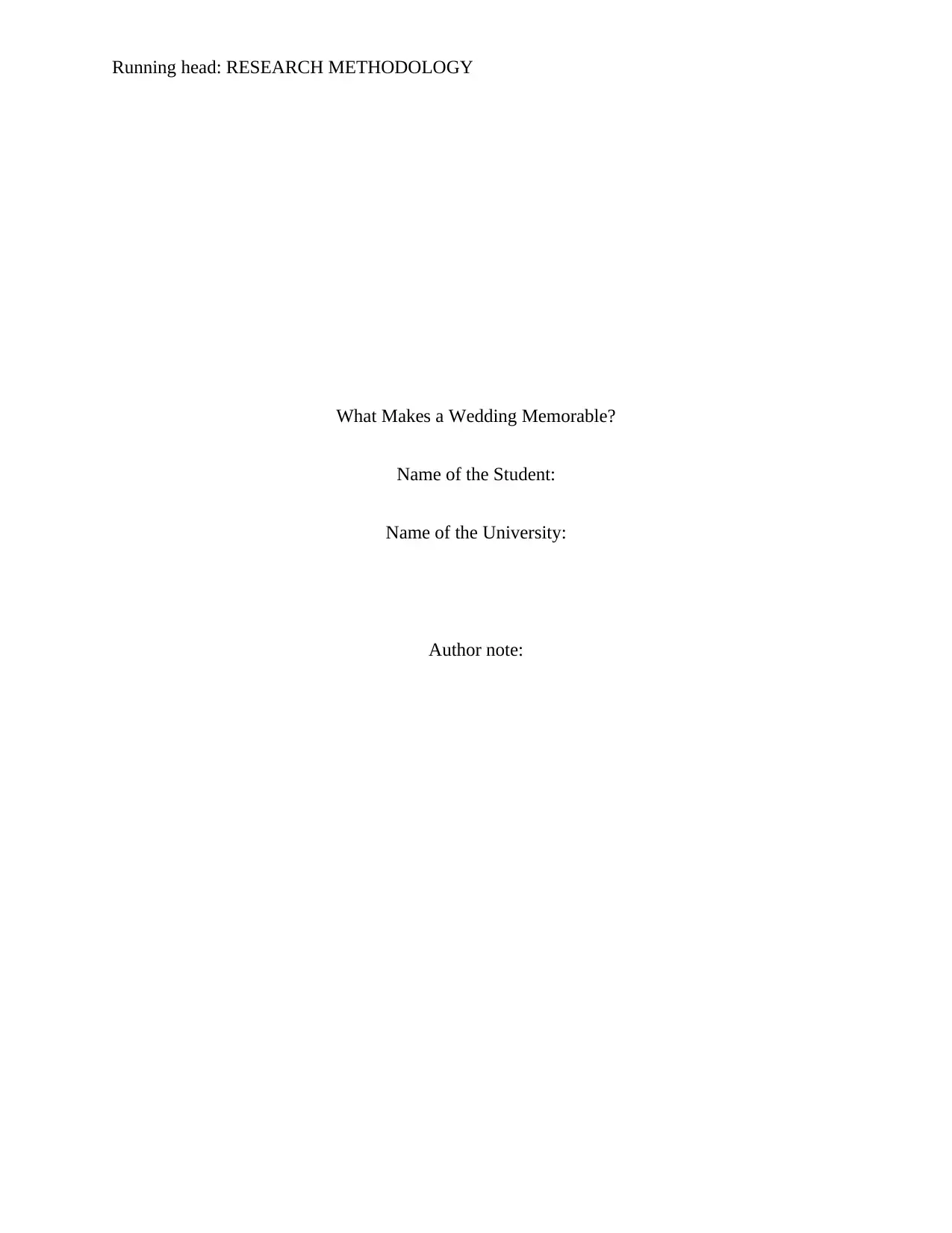
Running head: RESEARCH METHODOLOGY
What Makes a Wedding Memorable?
Name of the Student:
Name of the University:
Author note:
What Makes a Wedding Memorable?
Name of the Student:
Name of the University:
Author note:
Paraphrase This Document
Need a fresh take? Get an instant paraphrase of this document with our AI Paraphraser
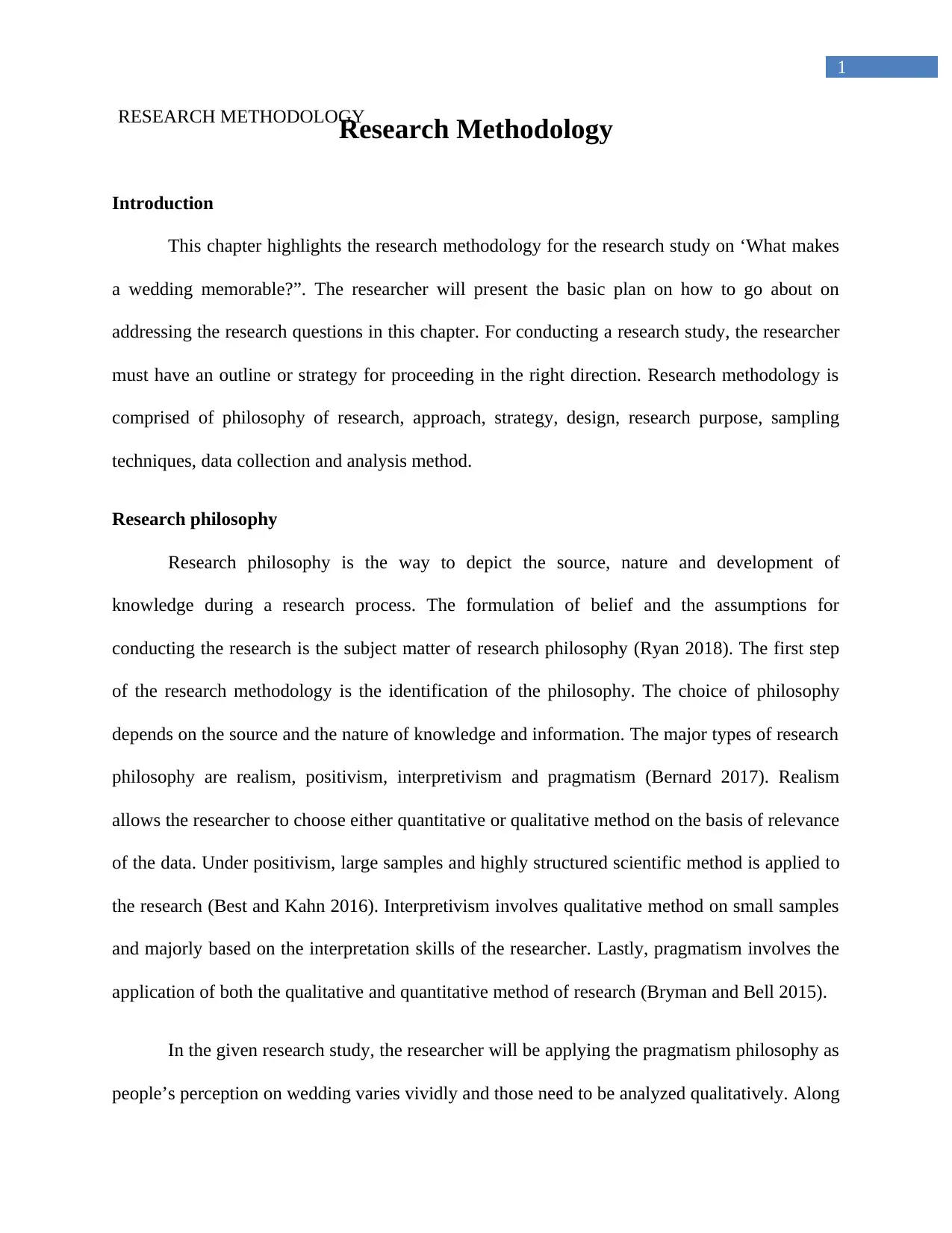
1
RESEARCH METHODOLOGY
Research Methodology
Introduction
This chapter highlights the research methodology for the research study on ‘What makes
a wedding memorable?”. The researcher will present the basic plan on how to go about on
addressing the research questions in this chapter. For conducting a research study, the researcher
must have an outline or strategy for proceeding in the right direction. Research methodology is
comprised of philosophy of research, approach, strategy, design, research purpose, sampling
techniques, data collection and analysis method.
Research philosophy
Research philosophy is the way to depict the source, nature and development of
knowledge during a research process. The formulation of belief and the assumptions for
conducting the research is the subject matter of research philosophy (Ryan 2018). The first step
of the research methodology is the identification of the philosophy. The choice of philosophy
depends on the source and the nature of knowledge and information. The major types of research
philosophy are realism, positivism, interpretivism and pragmatism (Bernard 2017). Realism
allows the researcher to choose either quantitative or qualitative method on the basis of relevance
of the data. Under positivism, large samples and highly structured scientific method is applied to
the research (Best and Kahn 2016). Interpretivism involves qualitative method on small samples
and majorly based on the interpretation skills of the researcher. Lastly, pragmatism involves the
application of both the qualitative and quantitative method of research (Bryman and Bell 2015).
In the given research study, the researcher will be applying the pragmatism philosophy as
people’s perception on wedding varies vividly and those need to be analyzed qualitatively. Along
RESEARCH METHODOLOGY
Research Methodology
Introduction
This chapter highlights the research methodology for the research study on ‘What makes
a wedding memorable?”. The researcher will present the basic plan on how to go about on
addressing the research questions in this chapter. For conducting a research study, the researcher
must have an outline or strategy for proceeding in the right direction. Research methodology is
comprised of philosophy of research, approach, strategy, design, research purpose, sampling
techniques, data collection and analysis method.
Research philosophy
Research philosophy is the way to depict the source, nature and development of
knowledge during a research process. The formulation of belief and the assumptions for
conducting the research is the subject matter of research philosophy (Ryan 2018). The first step
of the research methodology is the identification of the philosophy. The choice of philosophy
depends on the source and the nature of knowledge and information. The major types of research
philosophy are realism, positivism, interpretivism and pragmatism (Bernard 2017). Realism
allows the researcher to choose either quantitative or qualitative method on the basis of relevance
of the data. Under positivism, large samples and highly structured scientific method is applied to
the research (Best and Kahn 2016). Interpretivism involves qualitative method on small samples
and majorly based on the interpretation skills of the researcher. Lastly, pragmatism involves the
application of both the qualitative and quantitative method of research (Bryman and Bell 2015).
In the given research study, the researcher will be applying the pragmatism philosophy as
people’s perception on wedding varies vividly and those need to be analyzed qualitatively. Along
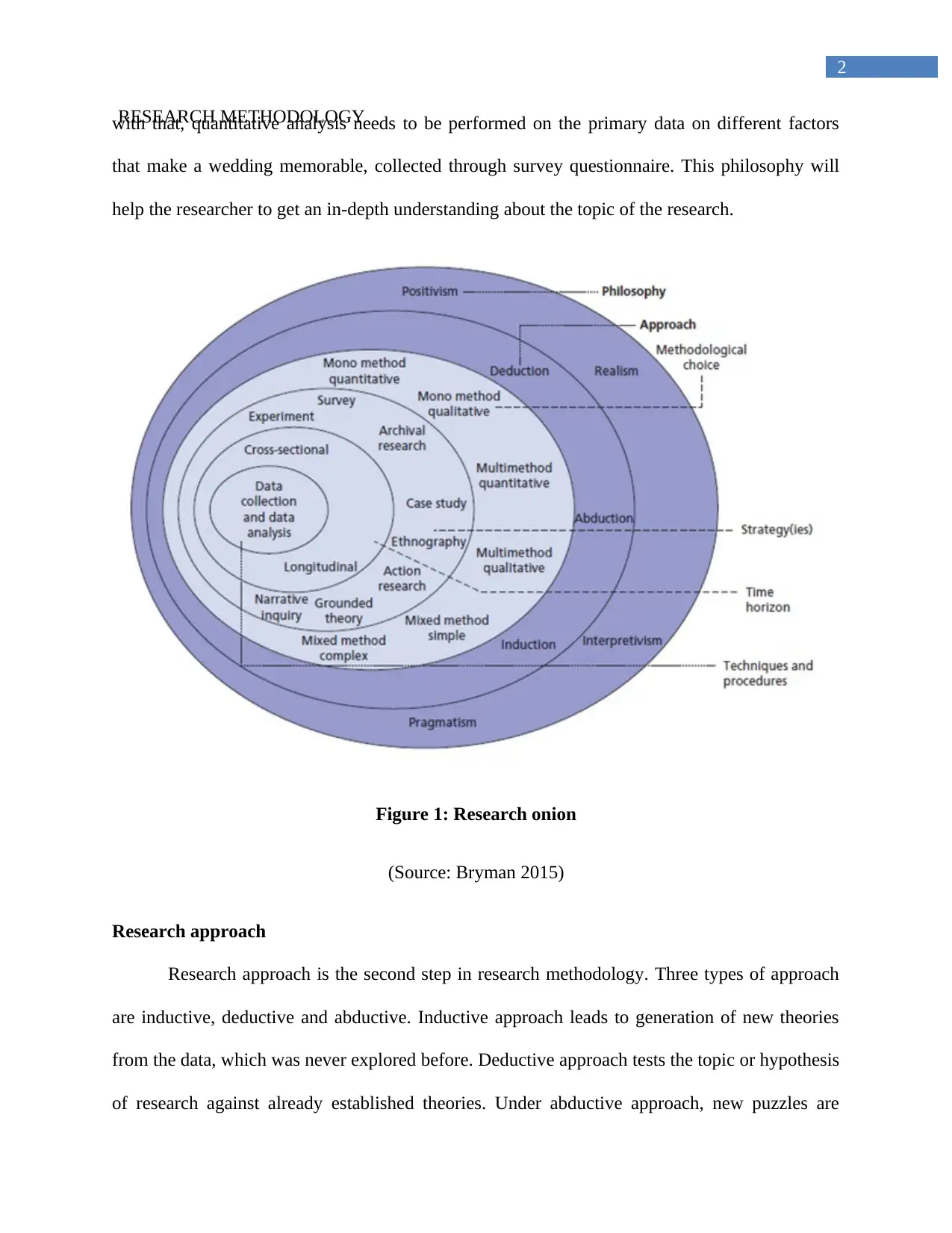
2
RESEARCH METHODOLOGYwith that, quantitative analysis needs to be performed on the primary data on different factors
that make a wedding memorable, collected through survey questionnaire. This philosophy will
help the researcher to get an in-depth understanding about the topic of the research.
Figure 1: Research onion
(Source: Bryman 2015)
Research approach
Research approach is the second step in research methodology. Three types of approach
are inductive, deductive and abductive. Inductive approach leads to generation of new theories
from the data, which was never explored before. Deductive approach tests the topic or hypothesis
of research against already established theories. Under abductive approach, new puzzles are
RESEARCH METHODOLOGYwith that, quantitative analysis needs to be performed on the primary data on different factors
that make a wedding memorable, collected through survey questionnaire. This philosophy will
help the researcher to get an in-depth understanding about the topic of the research.
Figure 1: Research onion
(Source: Bryman 2015)
Research approach
Research approach is the second step in research methodology. Three types of approach
are inductive, deductive and abductive. Inductive approach leads to generation of new theories
from the data, which was never explored before. Deductive approach tests the topic or hypothesis
of research against already established theories. Under abductive approach, new puzzles are
⊘ This is a preview!⊘
Do you want full access?
Subscribe today to unlock all pages.

Trusted by 1+ million students worldwide
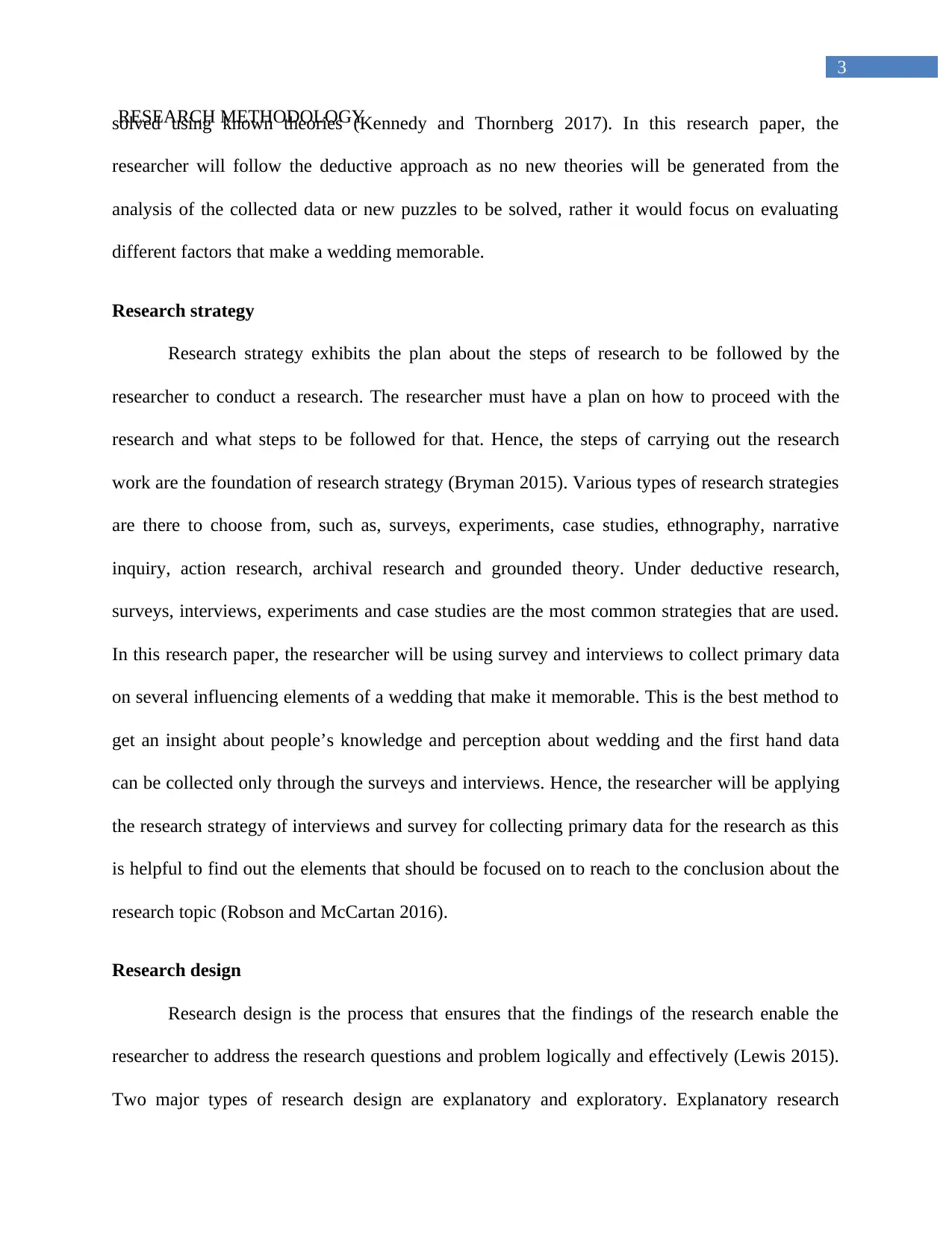
3
RESEARCH METHODOLOGYsolved using known theories (Kennedy and Thornberg 2017). In this research paper, the
researcher will follow the deductive approach as no new theories will be generated from the
analysis of the collected data or new puzzles to be solved, rather it would focus on evaluating
different factors that make a wedding memorable.
Research strategy
Research strategy exhibits the plan about the steps of research to be followed by the
researcher to conduct a research. The researcher must have a plan on how to proceed with the
research and what steps to be followed for that. Hence, the steps of carrying out the research
work are the foundation of research strategy (Bryman 2015). Various types of research strategies
are there to choose from, such as, surveys, experiments, case studies, ethnography, narrative
inquiry, action research, archival research and grounded theory. Under deductive research,
surveys, interviews, experiments and case studies are the most common strategies that are used.
In this research paper, the researcher will be using survey and interviews to collect primary data
on several influencing elements of a wedding that make it memorable. This is the best method to
get an insight about people’s knowledge and perception about wedding and the first hand data
can be collected only through the surveys and interviews. Hence, the researcher will be applying
the research strategy of interviews and survey for collecting primary data for the research as this
is helpful to find out the elements that should be focused on to reach to the conclusion about the
research topic (Robson and McCartan 2016).
Research design
Research design is the process that ensures that the findings of the research enable the
researcher to address the research questions and problem logically and effectively (Lewis 2015).
Two major types of research design are explanatory and exploratory. Explanatory research
RESEARCH METHODOLOGYsolved using known theories (Kennedy and Thornberg 2017). In this research paper, the
researcher will follow the deductive approach as no new theories will be generated from the
analysis of the collected data or new puzzles to be solved, rather it would focus on evaluating
different factors that make a wedding memorable.
Research strategy
Research strategy exhibits the plan about the steps of research to be followed by the
researcher to conduct a research. The researcher must have a plan on how to proceed with the
research and what steps to be followed for that. Hence, the steps of carrying out the research
work are the foundation of research strategy (Bryman 2015). Various types of research strategies
are there to choose from, such as, surveys, experiments, case studies, ethnography, narrative
inquiry, action research, archival research and grounded theory. Under deductive research,
surveys, interviews, experiments and case studies are the most common strategies that are used.
In this research paper, the researcher will be using survey and interviews to collect primary data
on several influencing elements of a wedding that make it memorable. This is the best method to
get an insight about people’s knowledge and perception about wedding and the first hand data
can be collected only through the surveys and interviews. Hence, the researcher will be applying
the research strategy of interviews and survey for collecting primary data for the research as this
is helpful to find out the elements that should be focused on to reach to the conclusion about the
research topic (Robson and McCartan 2016).
Research design
Research design is the process that ensures that the findings of the research enable the
researcher to address the research questions and problem logically and effectively (Lewis 2015).
Two major types of research design are explanatory and exploratory. Explanatory research
Paraphrase This Document
Need a fresh take? Get an instant paraphrase of this document with our AI Paraphraser
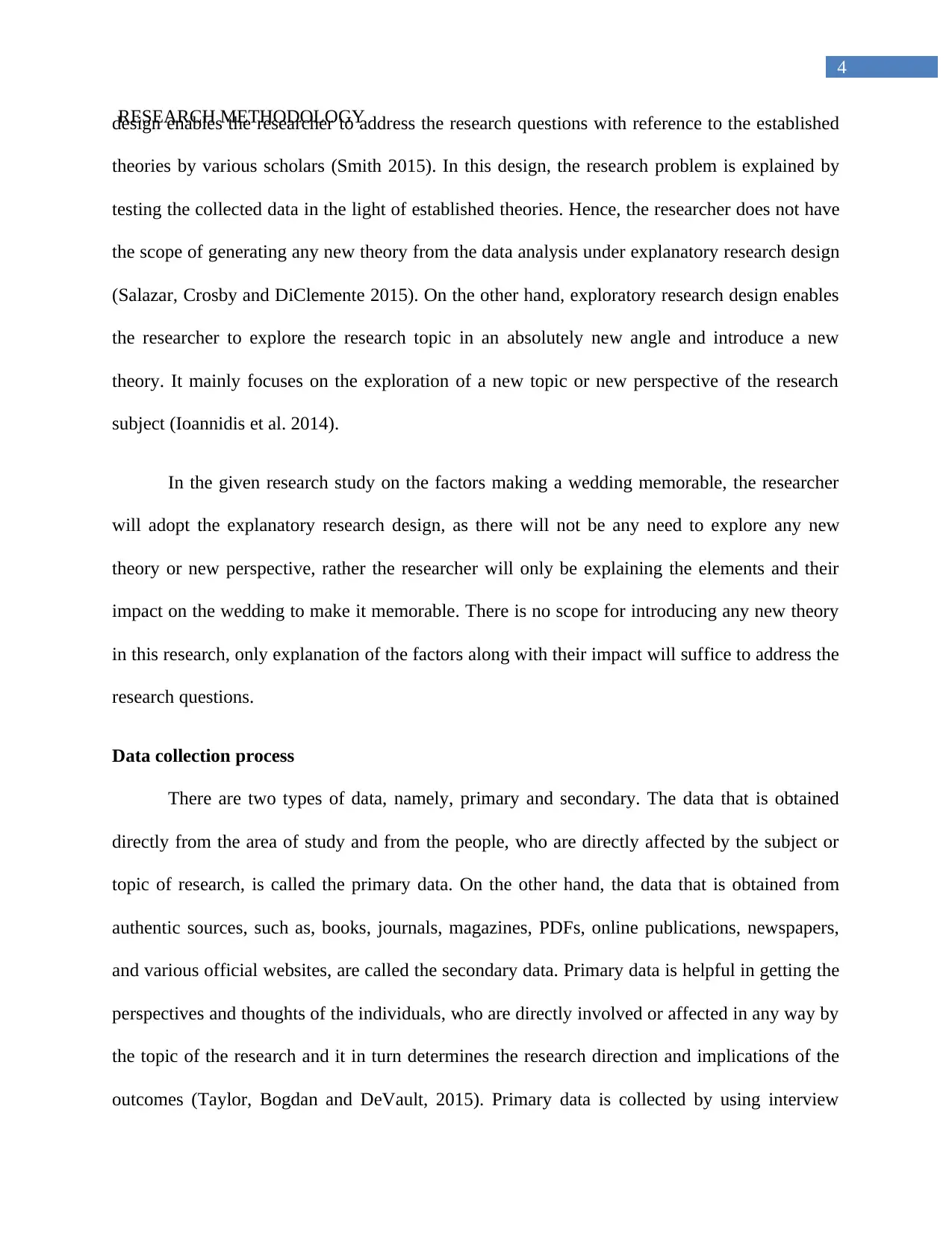
4
RESEARCH METHODOLOGYdesign enables the researcher to address the research questions with reference to the established
theories by various scholars (Smith 2015). In this design, the research problem is explained by
testing the collected data in the light of established theories. Hence, the researcher does not have
the scope of generating any new theory from the data analysis under explanatory research design
(Salazar, Crosby and DiClemente 2015). On the other hand, exploratory research design enables
the researcher to explore the research topic in an absolutely new angle and introduce a new
theory. It mainly focuses on the exploration of a new topic or new perspective of the research
subject (Ioannidis et al. 2014).
In the given research study on the factors making a wedding memorable, the researcher
will adopt the explanatory research design, as there will not be any need to explore any new
theory or new perspective, rather the researcher will only be explaining the elements and their
impact on the wedding to make it memorable. There is no scope for introducing any new theory
in this research, only explanation of the factors along with their impact will suffice to address the
research questions.
Data collection process
There are two types of data, namely, primary and secondary. The data that is obtained
directly from the area of study and from the people, who are directly affected by the subject or
topic of research, is called the primary data. On the other hand, the data that is obtained from
authentic sources, such as, books, journals, magazines, PDFs, online publications, newspapers,
and various official websites, are called the secondary data. Primary data is helpful in getting the
perspectives and thoughts of the individuals, who are directly involved or affected in any way by
the topic of the research and it in turn determines the research direction and implications of the
outcomes (Taylor, Bogdan and DeVault, 2015). Primary data is collected by using interview
RESEARCH METHODOLOGYdesign enables the researcher to address the research questions with reference to the established
theories by various scholars (Smith 2015). In this design, the research problem is explained by
testing the collected data in the light of established theories. Hence, the researcher does not have
the scope of generating any new theory from the data analysis under explanatory research design
(Salazar, Crosby and DiClemente 2015). On the other hand, exploratory research design enables
the researcher to explore the research topic in an absolutely new angle and introduce a new
theory. It mainly focuses on the exploration of a new topic or new perspective of the research
subject (Ioannidis et al. 2014).
In the given research study on the factors making a wedding memorable, the researcher
will adopt the explanatory research design, as there will not be any need to explore any new
theory or new perspective, rather the researcher will only be explaining the elements and their
impact on the wedding to make it memorable. There is no scope for introducing any new theory
in this research, only explanation of the factors along with their impact will suffice to address the
research questions.
Data collection process
There are two types of data, namely, primary and secondary. The data that is obtained
directly from the area of study and from the people, who are directly affected by the subject or
topic of research, is called the primary data. On the other hand, the data that is obtained from
authentic sources, such as, books, journals, magazines, PDFs, online publications, newspapers,
and various official websites, are called the secondary data. Primary data is helpful in getting the
perspectives and thoughts of the individuals, who are directly involved or affected in any way by
the topic of the research and it in turn determines the research direction and implications of the
outcomes (Taylor, Bogdan and DeVault, 2015). Primary data is collected by using interview
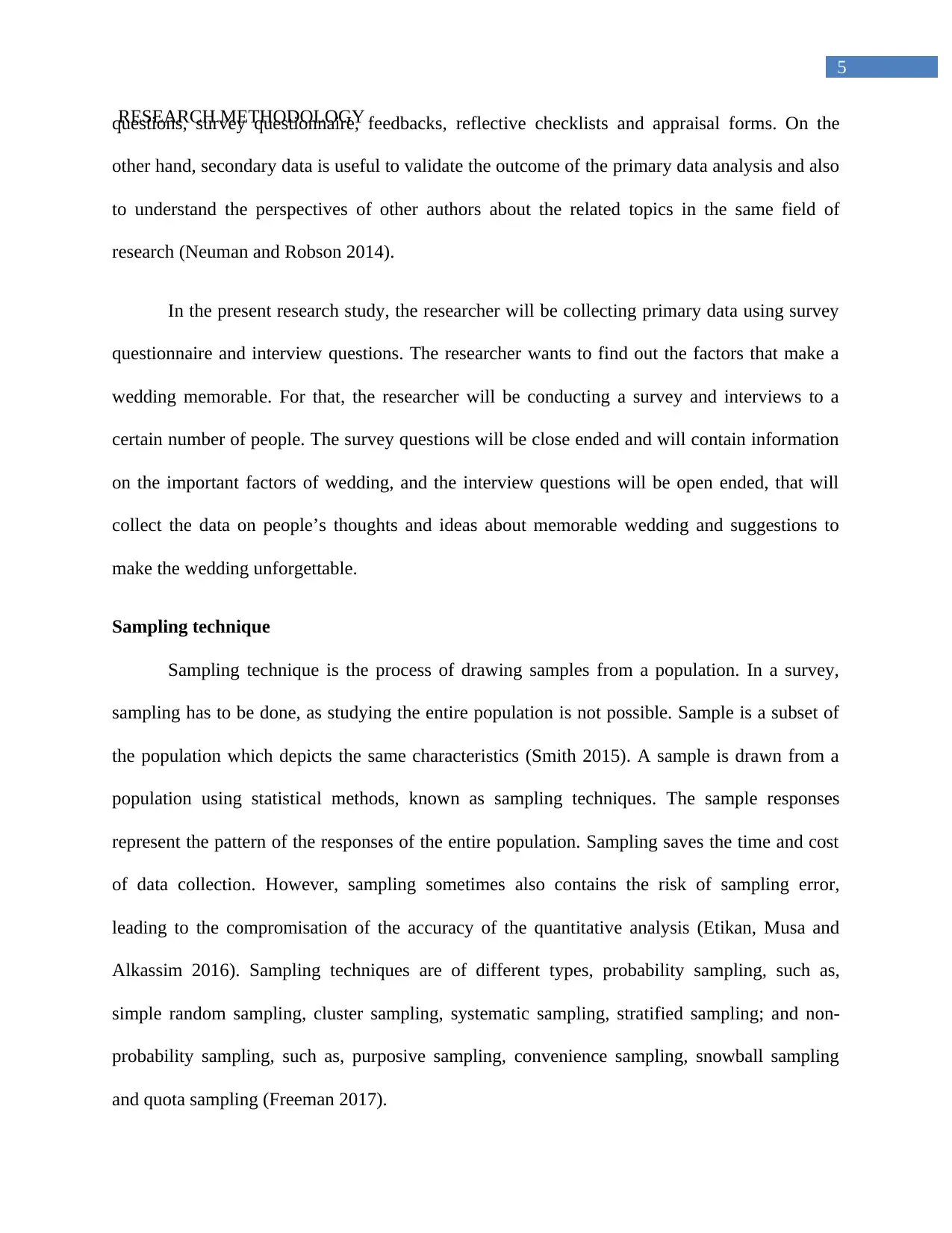
5
RESEARCH METHODOLOGYquestions, survey questionnaire, feedbacks, reflective checklists and appraisal forms. On the
other hand, secondary data is useful to validate the outcome of the primary data analysis and also
to understand the perspectives of other authors about the related topics in the same field of
research (Neuman and Robson 2014).
In the present research study, the researcher will be collecting primary data using survey
questionnaire and interview questions. The researcher wants to find out the factors that make a
wedding memorable. For that, the researcher will be conducting a survey and interviews to a
certain number of people. The survey questions will be close ended and will contain information
on the important factors of wedding, and the interview questions will be open ended, that will
collect the data on people’s thoughts and ideas about memorable wedding and suggestions to
make the wedding unforgettable.
Sampling technique
Sampling technique is the process of drawing samples from a population. In a survey,
sampling has to be done, as studying the entire population is not possible. Sample is a subset of
the population which depicts the same characteristics (Smith 2015). A sample is drawn from a
population using statistical methods, known as sampling techniques. The sample responses
represent the pattern of the responses of the entire population. Sampling saves the time and cost
of data collection. However, sampling sometimes also contains the risk of sampling error,
leading to the compromisation of the accuracy of the quantitative analysis (Etikan, Musa and
Alkassim 2016). Sampling techniques are of different types, probability sampling, such as,
simple random sampling, cluster sampling, systematic sampling, stratified sampling; and non-
probability sampling, such as, purposive sampling, convenience sampling, snowball sampling
and quota sampling (Freeman 2017).
RESEARCH METHODOLOGYquestions, survey questionnaire, feedbacks, reflective checklists and appraisal forms. On the
other hand, secondary data is useful to validate the outcome of the primary data analysis and also
to understand the perspectives of other authors about the related topics in the same field of
research (Neuman and Robson 2014).
In the present research study, the researcher will be collecting primary data using survey
questionnaire and interview questions. The researcher wants to find out the factors that make a
wedding memorable. For that, the researcher will be conducting a survey and interviews to a
certain number of people. The survey questions will be close ended and will contain information
on the important factors of wedding, and the interview questions will be open ended, that will
collect the data on people’s thoughts and ideas about memorable wedding and suggestions to
make the wedding unforgettable.
Sampling technique
Sampling technique is the process of drawing samples from a population. In a survey,
sampling has to be done, as studying the entire population is not possible. Sample is a subset of
the population which depicts the same characteristics (Smith 2015). A sample is drawn from a
population using statistical methods, known as sampling techniques. The sample responses
represent the pattern of the responses of the entire population. Sampling saves the time and cost
of data collection. However, sampling sometimes also contains the risk of sampling error,
leading to the compromisation of the accuracy of the quantitative analysis (Etikan, Musa and
Alkassim 2016). Sampling techniques are of different types, probability sampling, such as,
simple random sampling, cluster sampling, systematic sampling, stratified sampling; and non-
probability sampling, such as, purposive sampling, convenience sampling, snowball sampling
and quota sampling (Freeman 2017).
⊘ This is a preview!⊘
Do you want full access?
Subscribe today to unlock all pages.

Trusted by 1+ million students worldwide
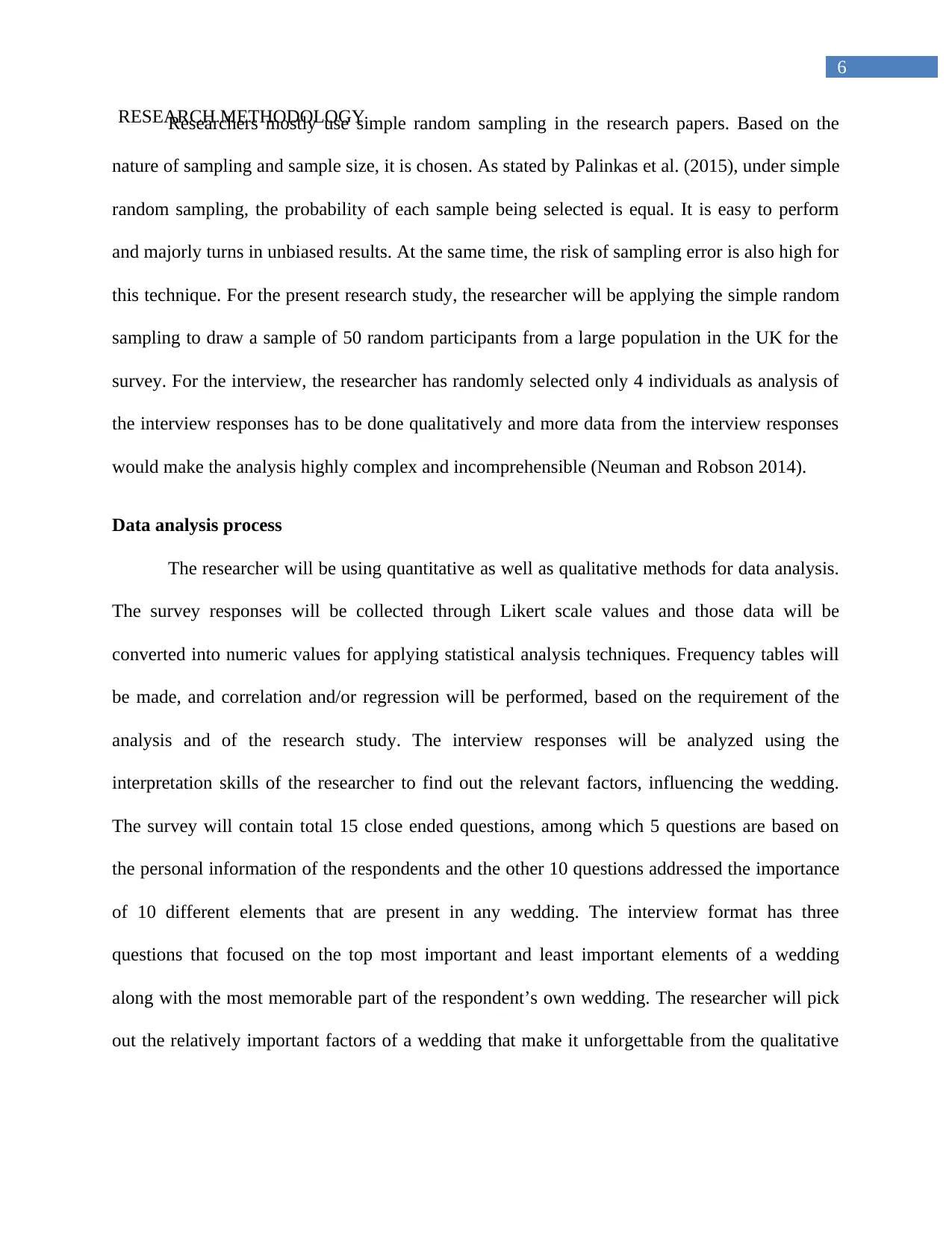
6
RESEARCH METHODOLOGYResearchers mostly use simple random sampling in the research papers. Based on the
nature of sampling and sample size, it is chosen. As stated by Palinkas et al. (2015), under simple
random sampling, the probability of each sample being selected is equal. It is easy to perform
and majorly turns in unbiased results. At the same time, the risk of sampling error is also high for
this technique. For the present research study, the researcher will be applying the simple random
sampling to draw a sample of 50 random participants from a large population in the UK for the
survey. For the interview, the researcher has randomly selected only 4 individuals as analysis of
the interview responses has to be done qualitatively and more data from the interview responses
would make the analysis highly complex and incomprehensible (Neuman and Robson 2014).
Data analysis process
The researcher will be using quantitative as well as qualitative methods for data analysis.
The survey responses will be collected through Likert scale values and those data will be
converted into numeric values for applying statistical analysis techniques. Frequency tables will
be made, and correlation and/or regression will be performed, based on the requirement of the
analysis and of the research study. The interview responses will be analyzed using the
interpretation skills of the researcher to find out the relevant factors, influencing the wedding.
The survey will contain total 15 close ended questions, among which 5 questions are based on
the personal information of the respondents and the other 10 questions addressed the importance
of 10 different elements that are present in any wedding. The interview format has three
questions that focused on the top most important and least important elements of a wedding
along with the most memorable part of the respondent’s own wedding. The researcher will pick
out the relatively important factors of a wedding that make it unforgettable from the qualitative
RESEARCH METHODOLOGYResearchers mostly use simple random sampling in the research papers. Based on the
nature of sampling and sample size, it is chosen. As stated by Palinkas et al. (2015), under simple
random sampling, the probability of each sample being selected is equal. It is easy to perform
and majorly turns in unbiased results. At the same time, the risk of sampling error is also high for
this technique. For the present research study, the researcher will be applying the simple random
sampling to draw a sample of 50 random participants from a large population in the UK for the
survey. For the interview, the researcher has randomly selected only 4 individuals as analysis of
the interview responses has to be done qualitatively and more data from the interview responses
would make the analysis highly complex and incomprehensible (Neuman and Robson 2014).
Data analysis process
The researcher will be using quantitative as well as qualitative methods for data analysis.
The survey responses will be collected through Likert scale values and those data will be
converted into numeric values for applying statistical analysis techniques. Frequency tables will
be made, and correlation and/or regression will be performed, based on the requirement of the
analysis and of the research study. The interview responses will be analyzed using the
interpretation skills of the researcher to find out the relevant factors, influencing the wedding.
The survey will contain total 15 close ended questions, among which 5 questions are based on
the personal information of the respondents and the other 10 questions addressed the importance
of 10 different elements that are present in any wedding. The interview format has three
questions that focused on the top most important and least important elements of a wedding
along with the most memorable part of the respondent’s own wedding. The researcher will pick
out the relatively important factors of a wedding that make it unforgettable from the qualitative
Paraphrase This Document
Need a fresh take? Get an instant paraphrase of this document with our AI Paraphraser
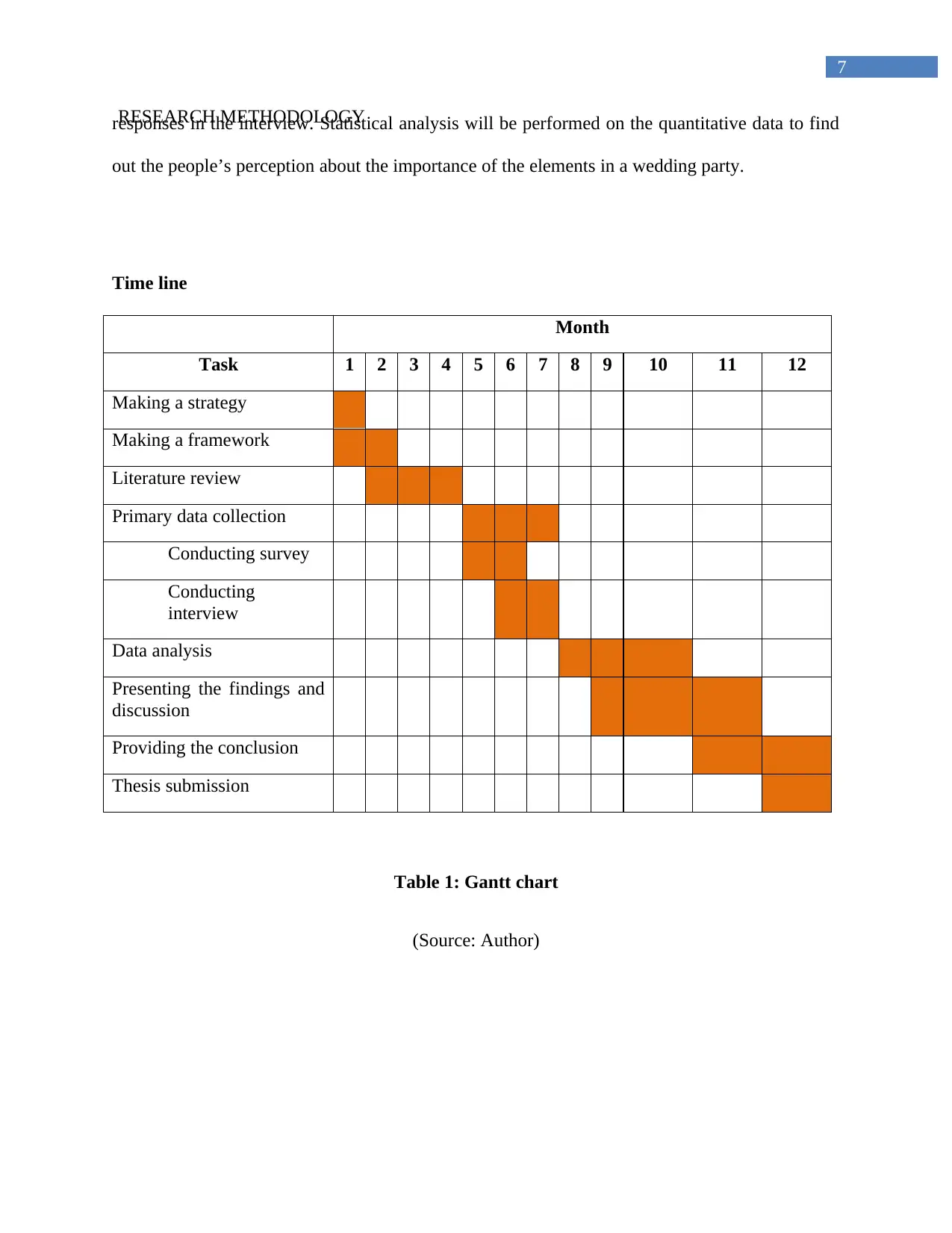
7
RESEARCH METHODOLOGYresponses in the interview. Statistical analysis will be performed on the quantitative data to find
out the people’s perception about the importance of the elements in a wedding party.
Time line
Month
Task 1 2 3 4 5 6 7 8 9 10 11 12
Making a strategy
Making a framework
Literature review
Primary data collection
Conducting survey
Conducting
interview
Data analysis
Presenting the findings and
discussion
Providing the conclusion
Thesis submission
Table 1: Gantt chart
(Source: Author)
RESEARCH METHODOLOGYresponses in the interview. Statistical analysis will be performed on the quantitative data to find
out the people’s perception about the importance of the elements in a wedding party.
Time line
Month
Task 1 2 3 4 5 6 7 8 9 10 11 12
Making a strategy
Making a framework
Literature review
Primary data collection
Conducting survey
Conducting
interview
Data analysis
Presenting the findings and
discussion
Providing the conclusion
Thesis submission
Table 1: Gantt chart
(Source: Author)
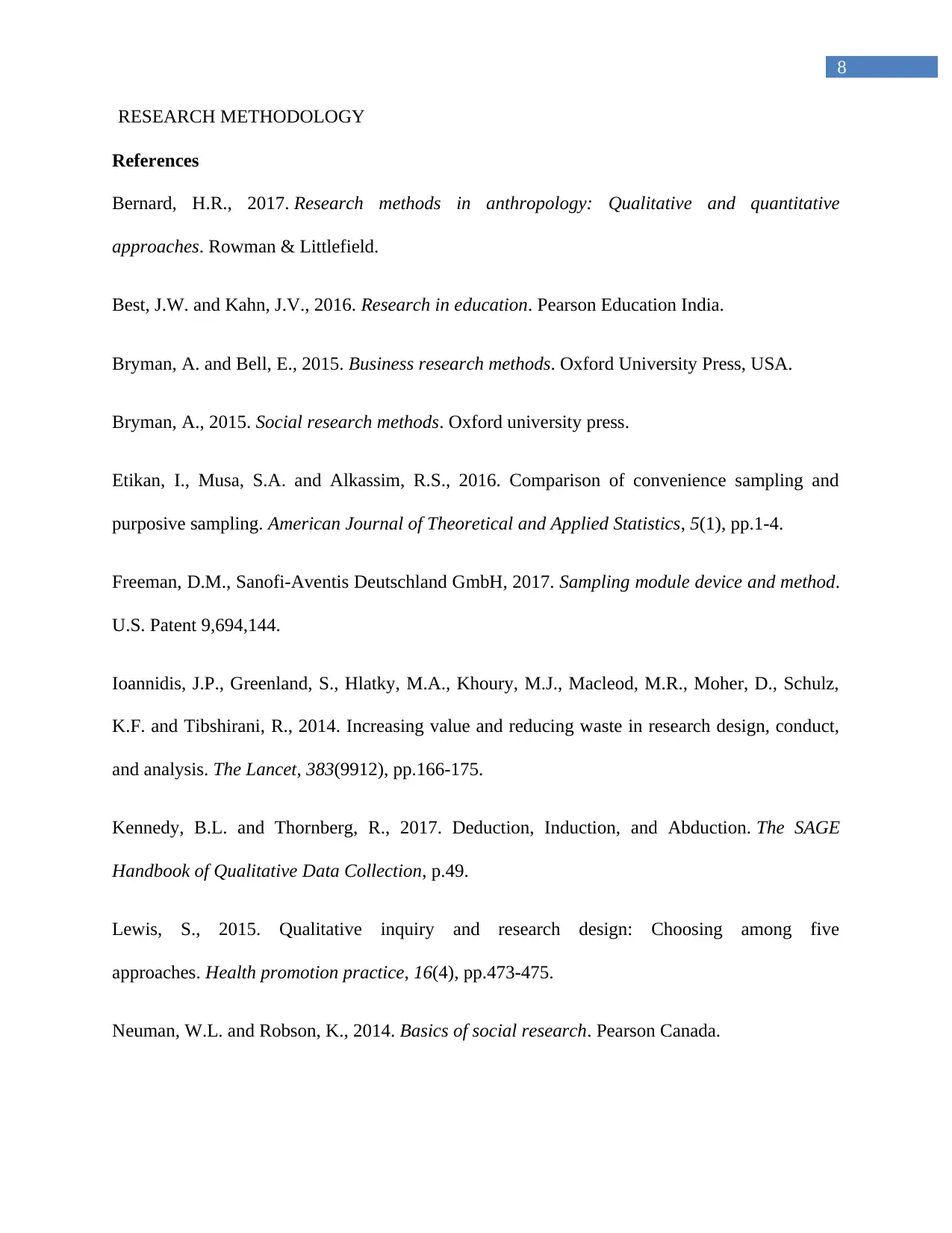
8
RESEARCH METHODOLOGY
References
Bernard, H.R., 2017. Research methods in anthropology: Qualitative and quantitative
approaches. Rowman & Littlefield.
Best, J.W. and Kahn, J.V., 2016. Research in education. Pearson Education India.
Bryman, A. and Bell, E., 2015. Business research methods. Oxford University Press, USA.
Bryman, A., 2015. Social research methods. Oxford university press.
Etikan, I., Musa, S.A. and Alkassim, R.S., 2016. Comparison of convenience sampling and
purposive sampling. American Journal of Theoretical and Applied Statistics, 5(1), pp.1-4.
Freeman, D.M., Sanofi-Aventis Deutschland GmbH, 2017. Sampling module device and method.
U.S. Patent 9,694,144.
Ioannidis, J.P., Greenland, S., Hlatky, M.A., Khoury, M.J., Macleod, M.R., Moher, D., Schulz,
K.F. and Tibshirani, R., 2014. Increasing value and reducing waste in research design, conduct,
and analysis. The Lancet, 383(9912), pp.166-175.
Kennedy, B.L. and Thornberg, R., 2017. Deduction, Induction, and Abduction. The SAGE
Handbook of Qualitative Data Collection, p.49.
Lewis, S., 2015. Qualitative inquiry and research design: Choosing among five
approaches. Health promotion practice, 16(4), pp.473-475.
Neuman, W.L. and Robson, K., 2014. Basics of social research. Pearson Canada.
RESEARCH METHODOLOGY
References
Bernard, H.R., 2017. Research methods in anthropology: Qualitative and quantitative
approaches. Rowman & Littlefield.
Best, J.W. and Kahn, J.V., 2016. Research in education. Pearson Education India.
Bryman, A. and Bell, E., 2015. Business research methods. Oxford University Press, USA.
Bryman, A., 2015. Social research methods. Oxford university press.
Etikan, I., Musa, S.A. and Alkassim, R.S., 2016. Comparison of convenience sampling and
purposive sampling. American Journal of Theoretical and Applied Statistics, 5(1), pp.1-4.
Freeman, D.M., Sanofi-Aventis Deutschland GmbH, 2017. Sampling module device and method.
U.S. Patent 9,694,144.
Ioannidis, J.P., Greenland, S., Hlatky, M.A., Khoury, M.J., Macleod, M.R., Moher, D., Schulz,
K.F. and Tibshirani, R., 2014. Increasing value and reducing waste in research design, conduct,
and analysis. The Lancet, 383(9912), pp.166-175.
Kennedy, B.L. and Thornberg, R., 2017. Deduction, Induction, and Abduction. The SAGE
Handbook of Qualitative Data Collection, p.49.
Lewis, S., 2015. Qualitative inquiry and research design: Choosing among five
approaches. Health promotion practice, 16(4), pp.473-475.
Neuman, W.L. and Robson, K., 2014. Basics of social research. Pearson Canada.
⊘ This is a preview!⊘
Do you want full access?
Subscribe today to unlock all pages.

Trusted by 1+ million students worldwide
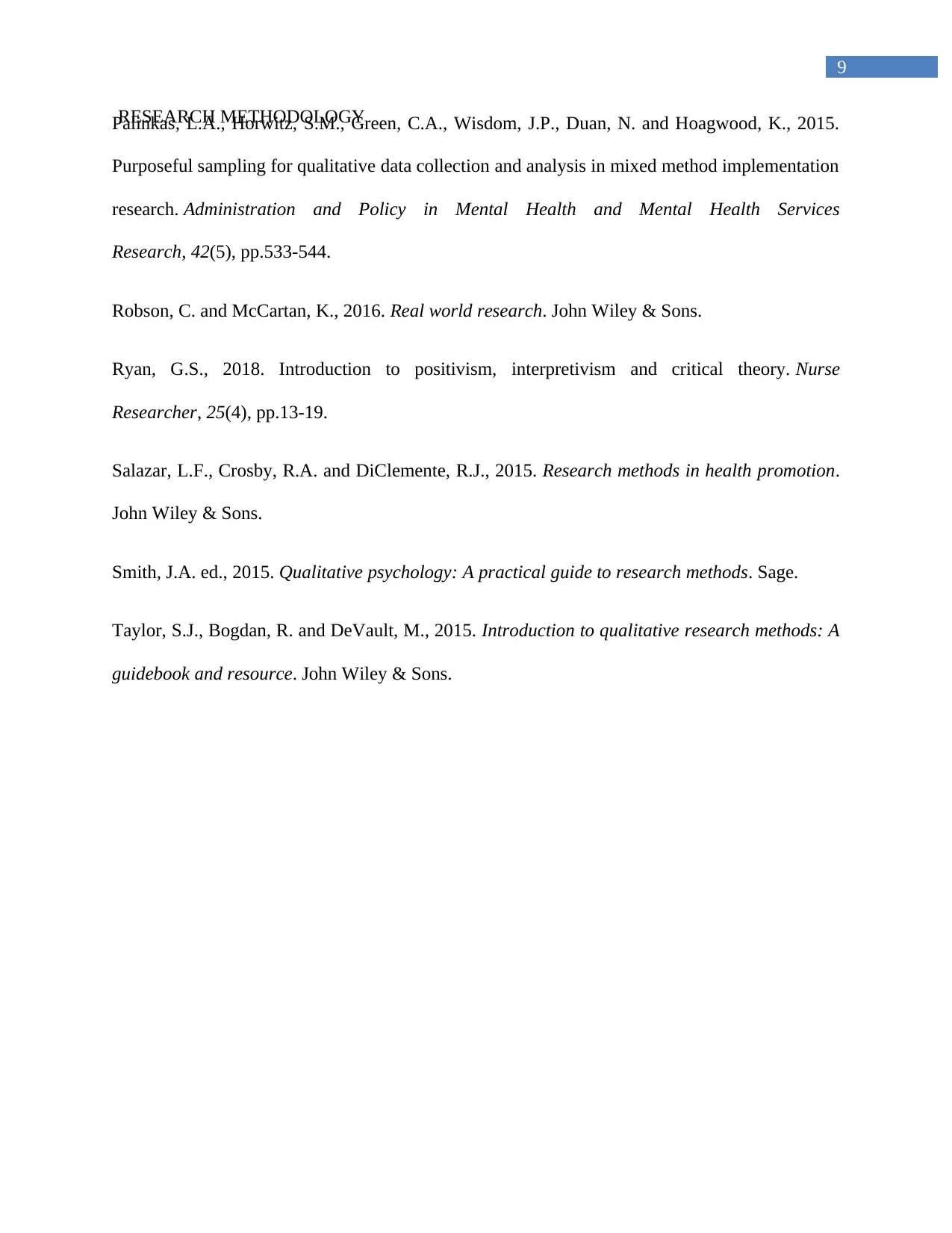
9
RESEARCH METHODOLOGYPalinkas, L.A., Horwitz, S.M., Green, C.A., Wisdom, J.P., Duan, N. and Hoagwood, K., 2015.
Purposeful sampling for qualitative data collection and analysis in mixed method implementation
research. Administration and Policy in Mental Health and Mental Health Services
Research, 42(5), pp.533-544.
Robson, C. and McCartan, K., 2016. Real world research. John Wiley & Sons.
Ryan, G.S., 2018. Introduction to positivism, interpretivism and critical theory. Nurse
Researcher, 25(4), pp.13-19.
Salazar, L.F., Crosby, R.A. and DiClemente, R.J., 2015. Research methods in health promotion.
John Wiley & Sons.
Smith, J.A. ed., 2015. Qualitative psychology: A practical guide to research methods. Sage.
Taylor, S.J., Bogdan, R. and DeVault, M., 2015. Introduction to qualitative research methods: A
guidebook and resource. John Wiley & Sons.
RESEARCH METHODOLOGYPalinkas, L.A., Horwitz, S.M., Green, C.A., Wisdom, J.P., Duan, N. and Hoagwood, K., 2015.
Purposeful sampling for qualitative data collection and analysis in mixed method implementation
research. Administration and Policy in Mental Health and Mental Health Services
Research, 42(5), pp.533-544.
Robson, C. and McCartan, K., 2016. Real world research. John Wiley & Sons.
Ryan, G.S., 2018. Introduction to positivism, interpretivism and critical theory. Nurse
Researcher, 25(4), pp.13-19.
Salazar, L.F., Crosby, R.A. and DiClemente, R.J., 2015. Research methods in health promotion.
John Wiley & Sons.
Smith, J.A. ed., 2015. Qualitative psychology: A practical guide to research methods. Sage.
Taylor, S.J., Bogdan, R. and DeVault, M., 2015. Introduction to qualitative research methods: A
guidebook and resource. John Wiley & Sons.
Paraphrase This Document
Need a fresh take? Get an instant paraphrase of this document with our AI Paraphraser
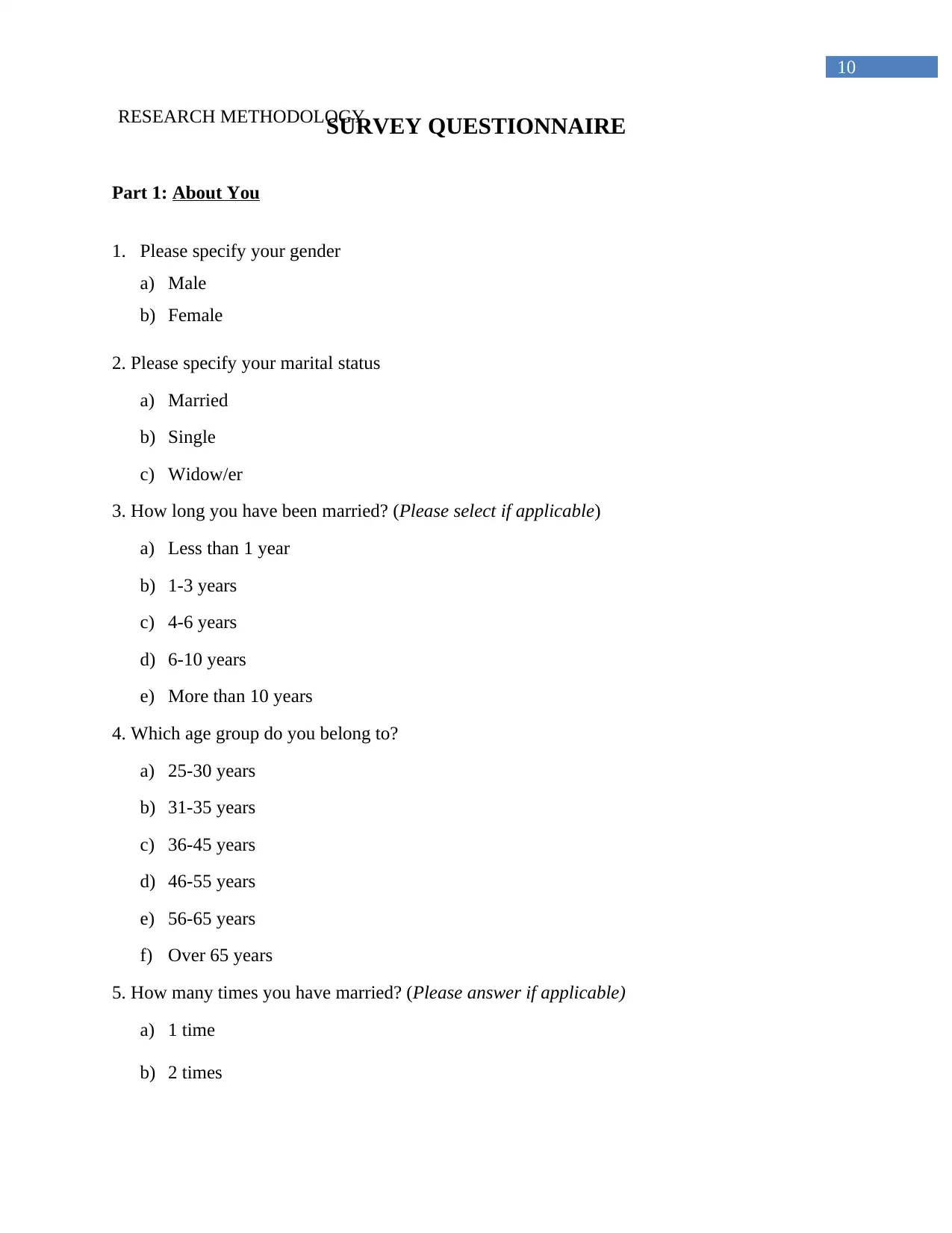
10
RESEARCH METHODOLOGY
SURVEY QUESTIONNAIRE
Part 1: About You
1. Please specify your gender
a) Male
b) Female
2. Please specify your marital status
a) Married
b) Single
c) Widow/er
3. How long you have been married? (Please select if applicable)
a) Less than 1 year
b) 1-3 years
c) 4-6 years
d) 6-10 years
e) More than 10 years
4. Which age group do you belong to?
a) 25-30 years
b) 31-35 years
c) 36-45 years
d) 46-55 years
e) 56-65 years
f) Over 65 years
5. How many times you have married? (Please answer if applicable)
a) 1 time
b) 2 times
RESEARCH METHODOLOGY
SURVEY QUESTIONNAIRE
Part 1: About You
1. Please specify your gender
a) Male
b) Female
2. Please specify your marital status
a) Married
b) Single
c) Widow/er
3. How long you have been married? (Please select if applicable)
a) Less than 1 year
b) 1-3 years
c) 4-6 years
d) 6-10 years
e) More than 10 years
4. Which age group do you belong to?
a) 25-30 years
b) 31-35 years
c) 36-45 years
d) 46-55 years
e) 56-65 years
f) Over 65 years
5. How many times you have married? (Please answer if applicable)
a) 1 time
b) 2 times
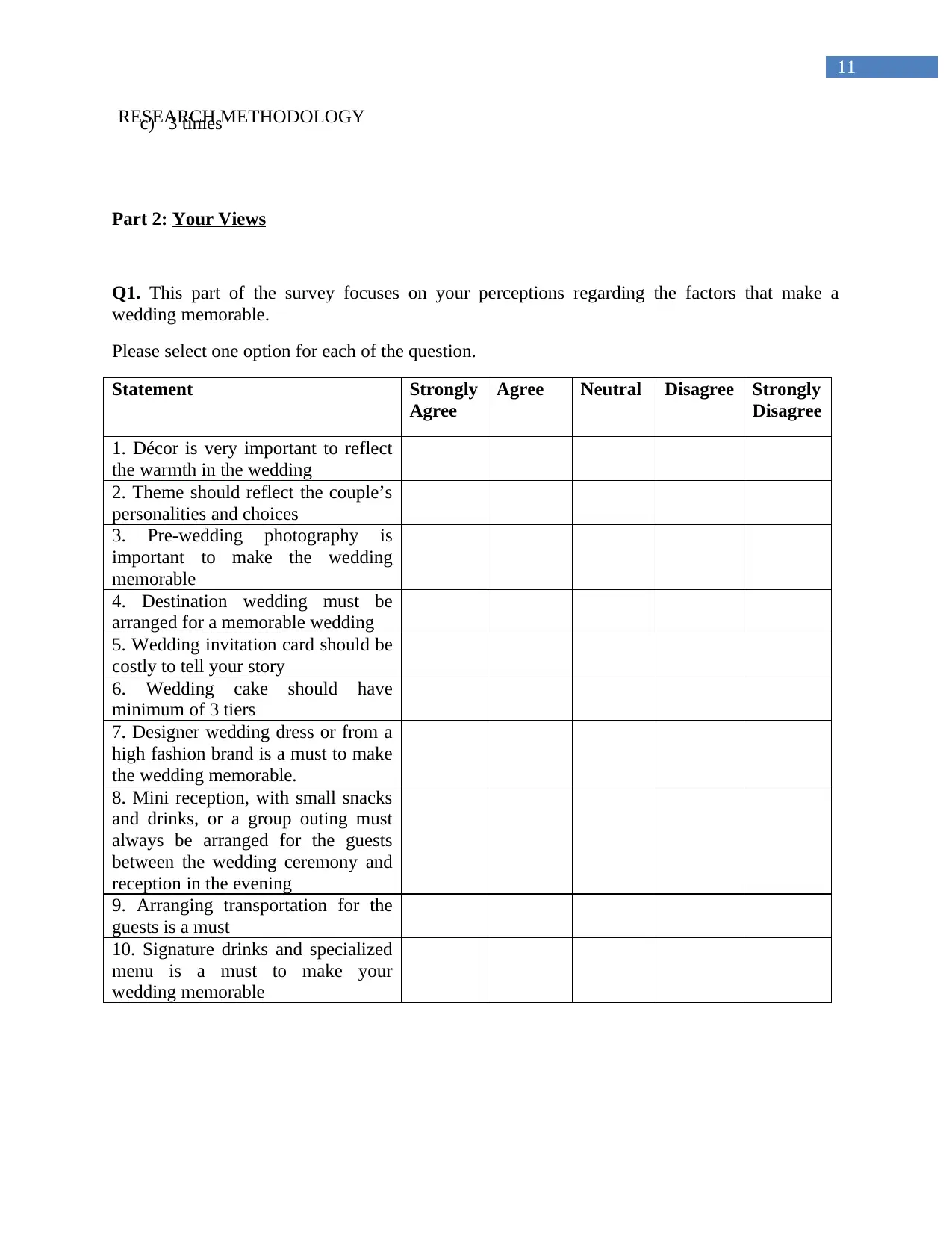
11
RESEARCH METHODOLOGYc) 3 times
Part 2: Your Views
Q1. This part of the survey focuses on your perceptions regarding the factors that make a
wedding memorable.
Please select one option for each of the question.
Statement Strongly
Agree
Agree Neutral Disagree Strongly
Disagree
1. Décor is very important to reflect
the warmth in the wedding
2. Theme should reflect the couple’s
personalities and choices
3. Pre-wedding photography is
important to make the wedding
memorable
4. Destination wedding must be
arranged for a memorable wedding
5. Wedding invitation card should be
costly to tell your story
6. Wedding cake should have
minimum of 3 tiers
7. Designer wedding dress or from a
high fashion brand is a must to make
the wedding memorable.
8. Mini reception, with small snacks
and drinks, or a group outing must
always be arranged for the guests
between the wedding ceremony and
reception in the evening
9. Arranging transportation for the
guests is a must
10. Signature drinks and specialized
menu is a must to make your
wedding memorable
RESEARCH METHODOLOGYc) 3 times
Part 2: Your Views
Q1. This part of the survey focuses on your perceptions regarding the factors that make a
wedding memorable.
Please select one option for each of the question.
Statement Strongly
Agree
Agree Neutral Disagree Strongly
Disagree
1. Décor is very important to reflect
the warmth in the wedding
2. Theme should reflect the couple’s
personalities and choices
3. Pre-wedding photography is
important to make the wedding
memorable
4. Destination wedding must be
arranged for a memorable wedding
5. Wedding invitation card should be
costly to tell your story
6. Wedding cake should have
minimum of 3 tiers
7. Designer wedding dress or from a
high fashion brand is a must to make
the wedding memorable.
8. Mini reception, with small snacks
and drinks, or a group outing must
always be arranged for the guests
between the wedding ceremony and
reception in the evening
9. Arranging transportation for the
guests is a must
10. Signature drinks and specialized
menu is a must to make your
wedding memorable
⊘ This is a preview!⊘
Do you want full access?
Subscribe today to unlock all pages.

Trusted by 1+ million students worldwide
1 out of 13
Related Documents
Your All-in-One AI-Powered Toolkit for Academic Success.
+13062052269
info@desklib.com
Available 24*7 on WhatsApp / Email
![[object Object]](/_next/static/media/star-bottom.7253800d.svg)
Unlock your academic potential
Copyright © 2020–2025 A2Z Services. All Rights Reserved. Developed and managed by ZUCOL.





